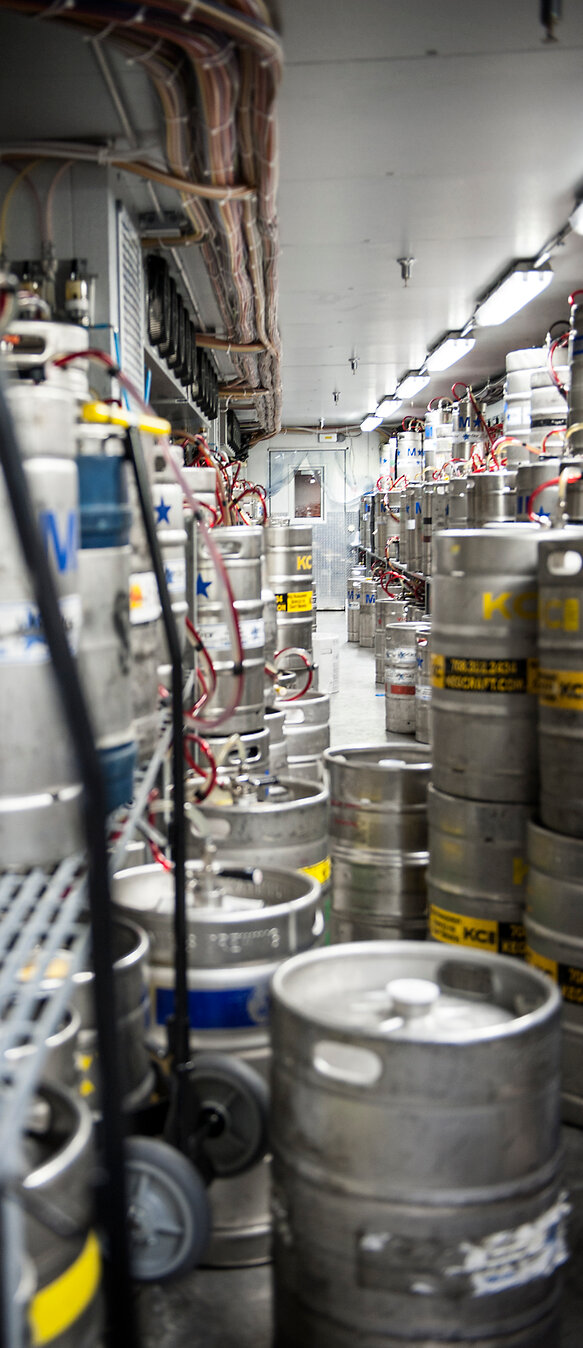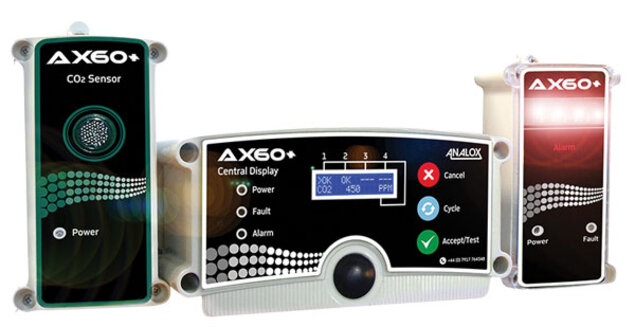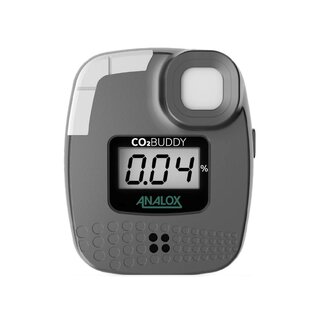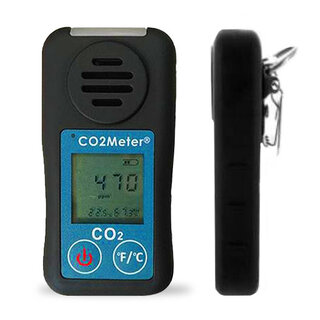Life-Saving Alarms for CO2 Leaks:
Safety Against Life-Threatening Hazards in the Workplace
CO2 gas: it’s tasteless, it’s odorless, it’s invisible, and it could be life-threatening. CO2 could be at dangerous levels in your walk-in. How would you know? This may seem like a heavy start to this topic, but Micro Matic is ADAMANT about bringing critical concerns to light in the beer and beverage dispensing industry. We believe that through education about CO2 leaks, we can protect and save countless lives from this seemingly invisible threat that is on the rise.
Why is CO2 Asphyxiation in Walk-In Coolers a More Common Problem than in the Past?
You probably have seen the semi-trucks before, the ones with all the CO2 tanks in the back. In the past, CO2 and other gas for dispensing beer were delivered in these tanks.
Like many other products, gas companies have found a way to be more efficient and effective. As with many industries, consolidation has become the norm in the gas supply business. These larger companies have really streamlined efficiencies by supplying bulk CO2 to even smaller outlets.
Instead of a truck carrying multiple cylinders and making multiple stops, a truck now carries a large amount of gas and refills bulk tanks on site. This allows the bar owner the convenience of having a much larger quantity of gas on-site, eliminating the need to change tanks frequently.
Bulk CO2 is convenient for everyone. From the gas company side, it means fewer deliveries. From a bar or restaurant’s business perspective, it’s more convenient and saves time. Additionally, they don’t have to worry about requesting more gas every 1-2 weeks or worse - running out of CO2.
The Problem with More CO2 Gas…
At first, this may seem like a non-issue, but the problem arises when you have leaks with your CO2 gas. Gas leaks are very common in beer and soda systems. When CO2 leaks out into an enclosed space, it will continue to leak until the supply is empty or the leak is fixed. If the retail location utilized smaller tanks of CO2, those cylinders typically wouldn’t have enough volume of CO2 to create a dangerous situation in a confined space or walk-in cooler. If multiple CO2 tanks are emptied in a short amount of time, the retailer would hopefully realize something is wrong and address the leak or leaks.
Since a bulk tank contains a much larger gas volume, it may be possible to leak dangerous amounts of gas into a confined space such as a walk-in before the retailer even knows there is an issue.
Gases such as CO2 and Nitrogen displace oxygen. If a leak or a combination of leaks is present, these gases can accumulate in the cooler or an enclosed space creating a lack of oxygen. The danger of CO2 goes beyond simply displacing oxygen. Even very low levels of CO2 in the air are dangerous. At CO2 levels exceeding 5% (50,000 ppm), the central nervous system (the brain and spinal cord) functions can become depressed and fail, causing unconsciousness. This can be fatal. The very real danger of CO2 is that it can make you unconscious with no warning! Most people who have become unconscious from CO2 exposure have no recollection of any problem until they wake up.
Is This Really an Industry Problem?
This is a big problem in the industry. Micro Matic includes CO2 monitors/alarms on most of the equipment quotes provided to various business channels. But to save on cost, only a small percentage of these quotes actually result in the purchase of a CO2 monitor/alarm.
While many microbreweries and pubs are popping up, many don’t understand or take precautions to prevent a disaster. But this is not exclusive to smaller businesses. There have been reported accidents and even deaths connected to CO2 leaks at sports arenas and other well-established business locations. Even though state laws may require there to be CO2 alarms, some choose to look past that.
Why Has This Become a Long-Overlooked Problem in Breweries?
It’s simple. How many business owners thought about the chemistry and physical science behind the molecules leaking into their walk-in coolers? Why would they, when they could, in the past, just easily fix the problem?
Without an understanding of the density of CO2 and the way it displaces oxygen, the thought probably never even occurred. Because the science behind CO2 is not often looked at in a brewery setting, we want to help explain.

What Happens When You Have a CO2 Leak in a Walk-In Cooler?
Walk-in coolers are often small, airtight rooms and any leak of CO2 will gradually cause a significant increase in CO2 levels. Since CO2 is both odorless and invisible, anyone walking into or working in a cooler will be unaware of its presence or concentration level. This means it is easy to have dangerous or lethal levels of CO2 in a cooler and be unaware of it.
How Can You Tell if You Have a CO2 Leak in Your Walk-In Cooler?
CO2 leaks can occur in various parts of a beverage dispensing system. Sometimes it is at the source of the gas (maybe the cylinder itself), sometimes at different points within the tapping system. The process of finding a leak can be difficult but costly if you don’t find it and fix it quickly.
The tough part about diagnosing a CO2 leak is that you can’t easily detect it with your five senses. CO2 is:
- Colorless
- Odorless
- Non-flammable
- Faintly acidic-tasting
- May or may not produce a burning sensation in the nostrils
This is why deaths associated with CO2 asphyxiation are so sudden. And just because the entire cooler may not be full of CO2, it can still be deadly even when normal oxygen levels are present. To identify if you have a CO2 leak large enough to be dangerous, you will need a CO2 monitor/alarm that can measure the levels of CO2 in the space and alert you to the danger.
Saving Lives and Reducing Hazards: How to Prevent Death or Injury from CO2 Leaks
Little changes to your current policies and setup could prevent death or injury—these range from changing protocols to installing ventilation systems or even simply purchasing detectors and monitors/alarms.
Implement Safety Checks, Protocols, and Educate Your Staff
Every commercial brewery, restaurant, or bar should already have safety hazard checks in place. This may include an inspection checklist, but we suggest implementing signage and employee education alongside any checks.
Another simple protocol would be ensuring that no one enters a walk-in cooler alone. You can implement a policy where an individual uses a walk-in cooler, and another individual should remain outside the walk-in cooler. This may not always be possible but could be a simple fix if you have two or more staff available during times the walk-in cooler is accessed. Although having a second individual accompany and “stay watch” while working in a walk-in cooler, it is important to note that it won’t alert others to changes in the environment before potential injury or death has occurred.
Properly Ventilating CO2 from Your Walk-In Cooler
If you are still in the process of installing everything for your walk-in cooler or are working on a remodel, it may be wise to consider how you can ventilate CO2. If you can ventilate any CO2 to an outside location, you redirect the gas to an area it can disperse. You’ll want to ensure all safety codes are met and that this doesn’t cause hazards in other locations, and whether this is possible with your current configuration. We recommend talking to your general contractor, designer, and any others involved at the time of installation
Protect Yourself and your Employees with CO2 Alarms and Detectors
One of the more practical solutions to implement is to buy CO2 monitors, alarms, and detectors. There are many options of detectors you can look at online. If you are purchasing with Micro Matic, we suggest looking at our selection of detectors as you consider solutions.
Make sure that your monitor/alarm will detect CO2 at low levels. There are monitors/alarms that will alert you at really low levels (such as 0.5% - 5,000 ppm).
You’ll also want to check that it is installed at the proper height. As mentioned earlier, CO2 gas is dense and will “sink” in a sealed, walk-in cooler. Therefore, you won’t want to be bending too far down into the potential layer of CO2 to check the detector and won’t want to put it too high up in the room.
Always follow manufacturer recommendations when installing a CO2 alarm. Typically, the sensor is installed around 12 inches from the floor. (International Fire Code, NBIC)

What if You Are Just a Service Tech that works in Walk-in Coolers?
Service technicians, such as HVAC and other commercial cooling experts, maybe doing one large service call or 10+ service calls in a day. Not protecting yourself against CO2 leaks is essentially playing with fire.
Even though you may not control the establishments and business protocols for CO2 safety hazards, you can protect yourself by asking them about their protocols and carrying your own personal, low-level CO2 detector.
At Micro Matic, we recommend using this personal MM-SAN-10 CO2 alarm or the CO2 Buddy Safety Monitor for all employees who work in confined spaces with CO2. It is about the size of a pager (if you remember what those are) and hangs on the individual’s belt. The alarm will go off when you walk into an enclosed space or cooler that contains as little as 5% CO2 in the air.


What Price Would You Put on Safety?
Many of us have worked in a bar or a restaurant at some point or another. Our sons and daughters may have also done so. Wouldn’t it be nice to know that somebody somewhere decided to install a simple piece of monitoring equipment that may one day save a life?
It’s About More than Educating Others of Brewery Hazards--It’s About Saving Lives with CO2 Alarms CO2 safety is an important part of the beverage dispensing industry. Although education is key, it requires businesses and employees to take action actually to make a change. We believe this is more than just educating individuals. We believe this is about saving lives. Implementing safety protocols, installing CO2 alarms in breweries, and mandating the use of personal CO2 detectors are just some of the ways to get started on making a change.
Raise a Glass to Draft Beer Sales!
For over 60 years, Micro Matic has been recognized as one of the world’s leading suppliers of draft beer equipment. Specializing in keg-to-glass technology, we offer a total solution for meeting your draft beer equipment needs. Our dedication to customer service is supported by four regional sales and distribution centers, the Micro Matic Dispense Institute for training and education, and a Certified Installer Network for draft beer installations. Want to speak with a “perfect pour” expert? Contact Micro Matic today.